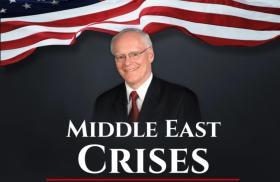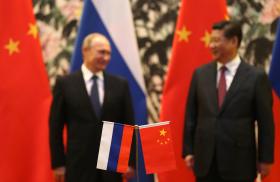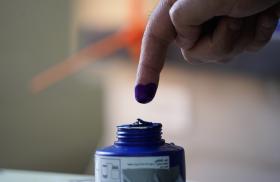- Policy Analysis
- PolicyWatch 4084
Violence in Suwayda: No “Plan B” for Syria?
A Syrian official and a panel of experts debate the response to recent sectarian bloodshed in the south, including what must be done to protect minorities and pursue true transitional justice post-Assad.
On July 28, The Washington Institute held a virtual Policy Forum with Qutaiba Idlbi, Andrew J. Tabler, Sawsan Abou Zainedin, and Mazen Ezzi. Idlbi is the Director of American Affairs at the Syrian Ministry of Foreign Affairs and Expatriates. Tabler is the Institute’s Martin J. Gross Senior Fellow and former senior advisor to the U.S. special envoy for Syria. Zainedin is a Syrian civil society professional who leads pioneering initiatives that center local agency, justice, and inclusive governance. Ezzi is a journalist, researcher, and editor of the Housing, Land, and Property Rights section of the Syria Report website. The following is a rapporteurs’ summary of their remarks.
Qutaiba Idlbi
The recent violence in Suwayda was rooted in longstanding tensions and complex factors. With its blend of distinct Druze communities and tribal groups, Suwayda is not like Syria’s coast or the northeast. Yet the same two key lessons from the March coastal violence still hold true: Syria must strengthen its military command and control structures while prioritizing an expedited, individualized process for disarmament, demobilization, and reintegration.
The state has intervened meaningfully in the latest violence to restore order. Following the killing of fifteen Interior Ministry personnel and kidnapping of thirty others, Suwayda’s communities accepted the presence of government forces to address the growing lawlessness—conditions that were stoked in part by former Assad regime officials hiding out in the area and affiliates of Iran’s Islamic Revolutionary Guard Corps continuing their smuggling of Captagon. This moment was significant: the Syrian government not only intervened, but did so with community acceptance, breaking up clashes and beginning the difficult process of stabilization. Yet Israel’s intervention on behalf of Druze militias exacerbated tensions and led to more intercommunal violence that took ten days for government authorities to help calm down through dialogue.
The government’s initial efforts have focused on cementing the ceasefire and addressing the most destabilizing issues in the governorate. Over 1,500 hostages—primarily women, children, and elderly people—were released. Aid convoys have entered affected areas, and basic services continue, even in zones where state symbols are absent. Yet Suwayda remains a complex political environment with fractured religious leaders, tribal dynamics, and remnants of the former regime. As in other parts of Syria, a fragile social contract is at play, and a few bad actors can significantly interrupt positive momentum.
Accountability will be central to moving forward. Investigations by the Ministries of Defense and Justice will evaluate conduct and violations by state forces and other actors. Justice must apply to all parties or reconciliation will be impossible.
There is cause for optimism even amid the ongoing challenges. Syrians continue to live alongside their neighbors despite community differences, showing collective discipline and a willingness to move past conflict. After fourteen years of war, most Syrians want peaceful political resolutions rather than a return to arms. To achieve this, however, they will need international support, especially with regard to limiting foreign interference and lifting UN sanctions that obstruct disarmament, demobilization, reintegration, and reconciliation.
Andrew J. Tabler
The language in Washington may have changed, but President Trump and other policymakers are still betting on Syria’s current government as the most legitimate authority to handle the transition. In late spring, the Trump administration strategically shifted its approach by front-loading incentives, chief among them sanctions relief. This enabled the U.S. government to take remarkable steps to dismantle comprehensive sanctions quickly, greatly incentivizing Damascus to follow through on the five points raised by President Trump on May 13: namely, joining the Abraham Accords with Israel, addressing the foreign fighter challenge, ejecting radical Palestinian groups, continuing operations against the Islamic State, and taking control of detention centers that hold thousands of IS members and their families. In the administration’s view, delivering results on these issues is what matters most.
Although the path is being cleared for them, the question remains whether Syria’s interim authorities will actually deliver. Crises like the sectarian violence that erupted in the coastal region this March and in Suwayda earlier this month demonstrate the government’s limited capacity to maintain control and security. Overall, the trajectory of minority integration in Syria is not moving in a positive direction post-Assad.
In this delicate context, Syrian officials must take steps to reverse the tide and prevent further escalation and instability. Foreign fighters—a key concern for international partners and Syrian civilians alike—need to be removed from the government and military, if not the country. Command and control within the Defense and Interior Ministries must address extremism within their ranks and quell concerns about the integration of minority forces. In reality, the government still has limited capacity and may not deliver immediately on all of Trump’s goals. Whatever the case, Syria needs a political process and needs it now. Without a viable political process and a shift toward power sharing, the historic relationship that the United States and Syria both seek to foster may sour.
Sawsan Abou Zainedin
The humanitarian situation in Suwayda remains dire, and the ceasefire is fragile. Despite official rhetoric promoting peace, the transitional government has blocked international aid organizations such as the International Committee of the Red Cross from entering the area and has downplayed systematic violence by portraying it as isolated abuse. This has deepened mistrust, particularly as the fact-finding committee on the March coastal events provided only partial explanations and largely dismissed the structural nature of the violence. As a result, many in Suwayda now reject the transitional government’s legitimacy and see it as contributing to sectarian division rather than promoting national unity.
At the political level, the pro-democracy movement in Suwayda remains fundamentally civil and rooted in demands for a democratic Syria based on citizenship and human rights. Yet national and international discourse often misrepresents the movement as religious or sectarian. The call for Israeli intervention by local leaders such as Sheikh Hikmat al-Hajri has further complicated and, in some cases, delegitimized genuine civil demands for democratic reform.
To rebuild trust, several urgent steps must be taken: independent international investigations into recent violence; full humanitarian access for aid organizations; formal acknowledgment of the systemic nature of military abuses; an end to the concentration of power in the hands of a narrow presidential circle and affiliates of Hayat Tahrir al-Sham (HTS); and meaningful engagement with local demands through transparent, inclusive political dialogue. After that, structural reforms must follow, such as decentralizing governance, reforming the security apparatus, and ensuring that constitutional protections are both inclusive and enforceable. Most important, reconciliation must not come at the expense of justice. Past efforts to stabilize Syria have too often reintegrated perpetrators and silenced victims in the name of civic peace. Without transparency, accountability, and genuine power-sharing, any political settlement risks repeating the same cycles of violence and exclusion that have led to the current crisis.
Mazen Ezzi
The humanitarian situation in Suwayda governorate is catastrophic. Between July 11 and 24, over 100,000 people were displaced amid intense shelling, home invasions, and summary executions. At least 2,000 people—mostly civilians, including many women and children—were killed. Attacks targeted essential infrastructure: the Suwayda National Hospital, wells, agricultural fields, grain stores, and a key mine. These acts were part of a larger effort to systematically target the Druze, a community that has already faced decades of discrimination and persecution.
The transitional government is directly responsible for the recent escalation and launched the first military assault on Suwayda in mid-July. Far from being a neutral authority, it has used road closures and the politicization of humanitarian aid to apply pressure to the Druze community. Despite a ceasefire brokered by the United States, the government and affiliated tribal forces have refused to withdraw, while Druze factions have complied fully. This highlights the authorities’ attempt to keep Suwayda under coercive control and their wider pattern of unchecked power, lack of accountability, and efforts to sideline marginalized minority groups.
Key humanitarian and political priorities include the immediate lifting of the siege on Suwayda, the opening of an official border crossing with Jordan to allow aid delivery, and full enforcement of the ceasefire—including the withdrawal of all non-local forces. Emergency aid must be delivered without delay, and U.S. agencies must be granted full access to support critical infrastructure reconstruction efforts.
Two potential paths forward have emerged. The first is the launch of a new, internationally mediated political process that rebuilds national consensus around pluralism, transparent elections, and a constitutional framework protecting basic rights. If that fails, Syria must explore decentralized, federal, or confederal models of governance that provide regional autonomy and safeguard minority communities. Without structural reform, the current governance model—based on theocratic authoritarianism—remains incompatible with the aspirations not only of the Druze, but of other minority and moderate communities across Syria.
This summary was prepared by Audrey Kost and Abigail Becker. The Policy Forum series is made possible through the generosity of the Florence and Robert Kaufman Family.






